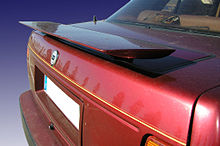Spoiler (vehicle)

In cars or trucks, a spoiler is a component whose main purpose is to influence the air flow around the vehicle.
Definition of terms
The terms spoiler and wing are often used synonymously in common parlance , but denote different things.
The term to spoil means in English "spoil (something), damage". The spoiler is only overflowed on one side. As a part of the vehicle, it creates a swirling, turbulent flow , which itself creates a higher resistance than laminar flow, but is better “attached” to the unsteady contour of the body, which reduces air resistance. "Rear spoilers" usually have the function of a spoiler. Front spoilers act as air deflectors, they direct the air around the vehicle and lower the pressure under it, which improves grip.
One speaks of a wing when the flow around both the top and bottom of the component. A wing generates aerodynamic downforce and thus a contact force for better traction. Depending on the specific design, it looks aerodynamically independent or it develops its effect in interaction with other components of the body, for example the side pods on racing cars.
How a spoiler works

In automobiles , especially in sports and racing cars , wings are rigid components made of plastic , rarely made of metal or carbon fiber reinforced plastic ("carbon"), which are intended to reduce the buoyancy of a body through the air flowing around them while driving. The reduction in buoyancy improves the transfer of forces to the ground and thus also the driving properties, in particular the possible lateral acceleration and thus cornering speed, driving stability and the braking distance at high speeds.
The reduction in lift forces is accompanied by an increase in air resistance (see polar ). In automotive aerodynamics, an efficient wing is a component that reduces lift while increasing drag as little as possible or, ideally, even reducing it.
Contrary to popular belief, the reducing lift force does not act directly on the spoiler itself, but is created by the changed pressure distribution on the vehicle body . In front of a spoiler raised on the top of a vehicle, the local pressure on the surface increases upstream. The force acting downwards on the surface perpendicular to the road surface, the product of pressure and area, also increases and thus ensures the desired reduction in lift.
At the same time, the currents can be very effectively disrupted there with little effort and little additional resistance. That is exactly the purpose of the spoilers: at the front, the air is deflected to the side instead of upwards over the bonnet; at the rear, the air is deflected upwards or totally blocked as with the first Audi TT and some series-production Porsches. If the air is cleverly directed around the particularly wide front wheels by the front spoiler, the overall resistance can even be reduced. But this is only the case if the spoiler takes components with particularly high air resistance out of the flow. But then the term aerodynamic cladding is also appropriate. Usually a spoiler increases the overall drag.
Designs



The following categories can be distinguished:
- Front spoiler or front spoiler , which reduce the lift forces on the front axle . With a good design, the air resistance can also be reduced and the cooling air supply for the engine and brakes can be improved (see aerodynamics )
- Rear spoiler , which lower the lift on the rear axle
- Wheel spoiler , component in front of the front and / or rear wheel to improve the wheel flow
- Side spoiler or side skirt , component on the side of vehicles, also on the front corner of a truck to improve the door area keeping dirt free
Emergence
The first spoiler was presented by Kamei in 1953. The so-called “depth control” was supposed to counter the considerable lift on the front axle of the VW Beetle , but at that time it was not well received. A few years later, a measurement in the wind tunnel showed that the sweeping construction reduced lift by 16%.
In the 1960s, Chaparral introduced spoilers in racing.
Regulations in Germany
With effect from November 2004, wide rear spoilers made of aluminum are no longer permitted in Germany by the StVZO . In general, these were particularly massive, sharp-edged spoilers, which were inspired as a fad by the feature film series The Fast and the Furious , among other things . In crash tests , especially in simulated collisions with pedestrians, a greatly increased risk of injury was found.
All spoilers are subject to registration unless they have a general operating permit (ABE), i.e. In other words, the owner of the vehicle is obliged to have the spoiler and the assembly checked and approved by an officially recognized expert. When buying spoilers, you should ensure that either an ABE or a parts certificate according to § 19.3 (vehicle-specific) is included. An entry in the vehicle documents with a material report / material confirmation should no longer be possible.
literature
- Hans-Hermann Braess, Ulrich Seiffert: Vieweg manual automotive technology. 2nd edition, Friedrich Vieweg & Sohn Verlagsgesellschaft mbH, Braunschweig / Wiesbaden, 2001, ISBN 3-528-13114-4 .
Web links
Individual evidence
- ↑ Felix Rehwald: Hidden Aerodynamics. May 10, 2003, accessed on November 20, 2019 (German).
- ↑ Thick Lippe: The depth control in the wind tunnel . Spiegel publishing house . March 18, 2009. Retrieved September 17, 2010.